The Hardenbergh Manor stands on land
purchased by Dutch/German immigrant Johannes Hardenbergh in 1706, and
confirmed by a royal letter patent in 1708. The 1.5 million acre tract,
which includes the majority of the Catskill Mountain region and large
portions of four New York counties, was the largest land transaction of
its kind the state�s colonial period.
|
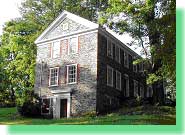 |
Isaac Hardenbergh (1755-1822),
grandson of Johannes Hardenbergh, later granted a significant
portion of the patent in eastern Delaware County, established a
manor farm at the confluence of the Bear Kill and the Schoharie
Creek about 1780.
He also established one of the earliest mills in
the region, maintained the area�s first store, and was instrumental
in the establishment of the Town of Roxbury in 1799. He served as
the town�s first supervisor between 1799 and 1806. He purchased
slaves as early as 1792 and is said to have been the largest
slaveholder in town. Slavery continued to be practiced by Hardenbergh until eliminated by law in 1827. |
|
|
The
east fa�ade of the house, with a center entrance suggests the influence
of the Georgian style in its symmetry and proportions. The detailed
brickwork around windows and doors recalls the Georgian practice using
contrasting materials dovetailed into the wall. The design of the house
departs from typical examples of Georgian architecture in its floor
plan, which has a central chimney, a small entrance vestibule and boxed
stairs in place of a central hall. Interiors were designed with exposed
floor joists, common in Dutch/German houses in eastern New York, but not
typically associated with the formality of Georgian interiors. The
scale of the house and the combination of Dutch/German and English
building techniques are unusual in the region.
Isaac
Hardenbergh�s eldest son, Lewis (1783-1838) took over and was Postmaster
of Hardenbergh Mills 1815-1822 and Town Supervisor 1828-1829. Farming
and milling operations on the Hardenbergh property expanded during this
period and it is likely that the frame addition to the stone house was
built during these years. Upon Lewis� death in 1838, the operation was
continued by Isaac Hardenbergh II, (1822-1889), Lewis� eldest son.
Isaac managed the property during the years of unrest accompanying the
Anti-rent wars of the 1840�s and sold off much of his grandfather�s
lands in eastern Delaware County when it become evident that the
increasingly militant inhabitants of the region would no longer tolerate
leaseholds. However, at least 1,200 acres remained associated with the
manor farm near Prattsville. |
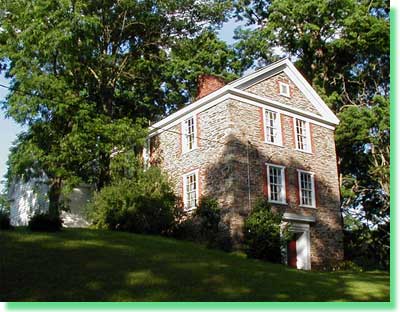
|
|
By the
1880�s, the family�s mill on the Bear Kill was described as decayed.
Farming turned to dairying about this time, shown by the remains of the
large, late 19th century cow barn still located on the property. The
frame portion of the house sustained a fire in 1881, which caused minor
damage.
When Isaac died in 1889, his daughter, Agnes (1885-1933) took over the
property about 1906 and developed it as a tourist home, adding verandahs
to the east elevation of the house, cobblestone plinths alongside the
entrance and cobblestone gateposts with millstones on either side of the
driveway. Guests traveling to the house from New York City arrived in
Grand Gorge by train and traveled the three remaining miles to the house
by car.
In a brochure, it advertised conveniences almost as modern as today's e-mail ... "Three
mails a day" ! Guests were picked up by car (!) at the Grand Gorge
Railway station of the Ulster & Delaware Railroad. Rates
were $12-15 a week.
At least 200 acres of Hardenbergh farmland in the rich agricultural
flats along the Schoharie Creek were acquired by New York City for the
development of the Schoharie Reservoir, built between 1919 and 1927.
The millstones built into the two gateposts may have been removed from a
nineteenth century gristmill near the base of the Hardenbergh Falls
before it was demolished. |
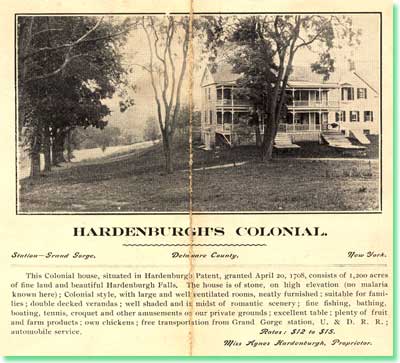 |
|
Agnes
Hardenbergh died in 1933, marking the end of the Hardenbergh�s tenure on
the land. The remaining 900 acres were sold at auction in 1934 to J.B.
Merwin.
Merwin maintained an apiary at the farm and used the house for storage
and antique sales. After the dairy barn collapsed in the 1950�s, the
property was sold to Dr. and Mrs. James Veith in 1958.
The Veith�s removed the deteriorating guesthouse verandahs and made
numerous structural repairs to the house.
Mr. and Mrs. Livingston Baker purchased the property in 1968 and have
continued to maintain the house without significant alterations or
modifications.
The
names Hardenbergh and Hardenburg have been used interchangeably in many
of the historical documents.
|
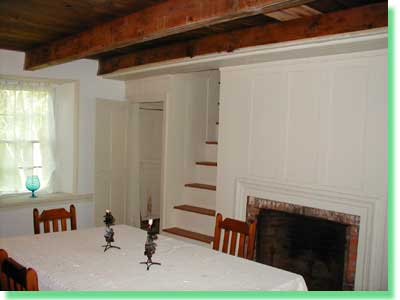 |
|
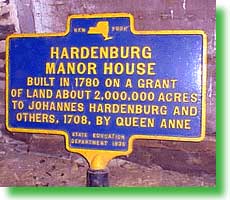
Hardenburg Manor House
Historical marker
|
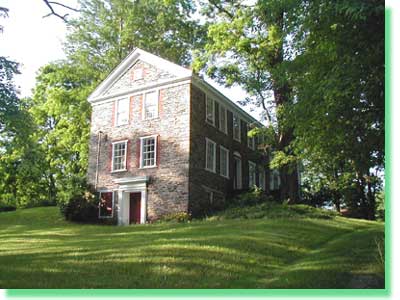
|
|